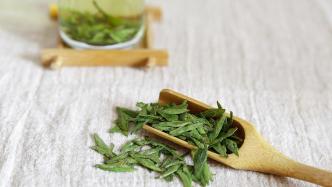
"What's going on in the mountains? Brew wine with pine flowers, brew tea with spring water." In the poems and essays of Zhang Kejiu, a poet in the Yuan Dynasty, the rise and fall of the ages and the troubles of the world can be forgotten in a cup of tea. Starting from the Chinese legend that "tea is drunk, it originated from Shennong's family", a small bud leaf has traveled through five thousand years, carrying civilizations of different eras, and blended into a glass of clear water in the hands of the world.
Tea is not only material, but also spiritual. Since the Tang and Song dynasties, the literati of all dynasties have continued to love tea, visiting tea mountains, looking for tea, remembering tea events, drawing pictures of tea, and expressing their elegant feelings. Among the mountains and wild bamboo forests, beside the strange stones of pine and bamboo, one may chat with Ke Qing, or explore the mysteries and participate in good fortune. The participation of literati and refined scholars makes tea transform from a natural tea to a spiritual carrier containing culture and emotion.
Throughout the history of tea, it can be said that it is the evolution history of Chinese life aesthetics, and it is also a history of art. "The Paper·Ancient Art" will start today from the perspectives of tea-picking scene, poetry and painting art, utensil aesthetics, etc., looking for the leisure and freedom that Chinese literati and refined scholars entrusted to a cup of tea, and pursuing the beauty of Chinese tea culture.
Just before tomorrow, you might as well have a cup of "Tea in the Best Taste - West Lake Longjing".

Wen Zhengming's "Zhenshangzhai Picture" depicts the scene of literati tasting tea in the mountains and forests

Tea pickers pick young shoots of Longjing Mingqian tea in a tea garden in the first-level protected area of Longjing origin in West Lake, Hangzhou.
In the treasure house of Chinese tea culture, West Lake Longjing tea is highly praised by the world as the leader of green tea. Longjing tea, named after Longjing, originated in the Song and Yuan Dynasties, was heard in the Ming Dynasty, flourished in the Qing Dynasty, and lasted for nearly a thousand years. "Green color, rich fragrance, sweet taste, beautiful shape" tea lovers must not miss a cup of West Lake Longjing in spring. The unique natural environment, exquisite craftsmanship and profound humanistic connotation of West Lake Longjing tea have not only created the reputation of West Lake Longjing tea, but also made West Lake Longjing the spiritual carrier of West Lake regional culture.
(one)
In early spring, new tea sprouts. In mid-March, the Hangzhou government announced the mining of West Lake Longjing. After just two or three sunny days, it began to rain continuously. Therefore, the large-scale mining of Longjing this year is also a little later than in previous years. However, this can’t stop the impatient tea drinkers. Every year when the Tomb-sweeping Day comes, Longjing Village of West Lake becomes very busy. An endless stream of tea drinkers and tourists flock to the village, hoping to drink a cup of picked tea at the first time. The tea leaves plucked from the buds and leaves of tea trees that germinate after overwintering are called spring tea. The energy accumulated throughout the winter, the tea buds wake up, the accumulation of nutrients in the tea tree reaches the peak, and the tea made from the green tea in spring tastes fresh and moist and resistant to brewing.
Tea picking is not only related to the quality of tea and the level of yield, but also related to the ups and downs of tea tree growth. At dawn, the tea farmers in Longjing Village were fully dressed and set out to go up the mountain. Although some tea gardens have begun mechanized picking, famous teas such as West Lake Longjing and Dongting Biluochun are still picked by hand, which can guarantee the standard and quality of picking. The green hills in the sky are undulating and rolling, and the mist and mist appear and disappear from time to time. Follow the tea pickers to climb up the tea garden, but watch their hands flying up and down between the tea canopies, picking greens into baskets. The method is simple and neat, but it has a lot of tricks when you look closely.
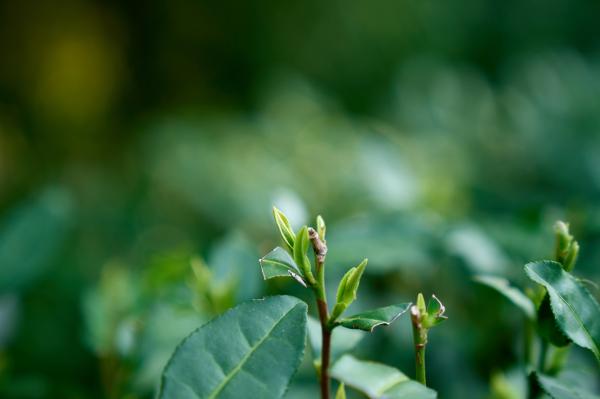
The new buds germinated from the tea tree, each bud and one leaf are shaped like a "sparrow beak", photography: owner Zhu Ning
Tea farmers use the hand-picking method, with the palm facing up, the thumb and forefinger clamp the tender stem above the fish leaf, and gently lift upwards, the tea leaves will fall to the palm; do not pinch, stroke, or grasp to avoid the fracture from turning red and damaging the color. taste. West Lake Longjing also has extremely high requirements on the tenderness of fresh leaves. Generally, tea buds, one bud and one leaf, and new shoots with one bud and two leaves are picked. When a bud and a leaf just unfold, it looks like a "sparrow's mouth", so the ancients called it "sparrow's tongue".

The picked buds and leaves need to be spread thinly in time

Tea farmers in Meijiawu Village, Hangzhou fry fresh Longjing leaves by hand. People’s Vision Xinhua News Agency

A good Longjing is like a bowl nail, (the bowl nail is a nail that mends the bowl, the tip of both ends is slightly wider in the middle)
In order not to make the delicate buds and leaves turn red after being squeezed, tea farmers must quickly go down the mountain and spread the fresh leaves in a cool place after picking, so that the buds and leaves lose part of the water and green grass gas, reduce the bitterness and astringency, and improve the freshness. After the finished tea leaves are spread out, they enter the frying process. The tea never leaves the pot, and the pot never leaves your hand. The frying of West Lake Longjing is all done by the hands of the tea masters flexibly changing the techniques in the special iron pot. Emperor Qianlong had a poem "Slow frying and fine roasting have steps, and there is a lot of hard work", which made it difficult for tea making to overflow on paper.
In Longjing Village, almost every local tea farmer roasts tea. The clear taste of Manshan tea gardens and the aroma of roasted tea wafts through the mountains and fields. From Longjing tea gardens to the shore of West Lake, this area of lakes and mountains is a large tea house bestowed by nature.
(two)
How does the landscape of West Lake breed good tea? How to appreciate the literati aesthetics behind Longjing? Every spring is also the busiest time for Wang Jianrong, a tea science expert and former curator of the China Tea Museum, and there are countless tea lovers who come to Wang Jianrong to discuss the "truth".

Longjing Village Tea Garden Photography: Owner Zhu Ning
"A good tea garden has an unchanging model. Lu Yu, the 'tea sage', used in the "Tea Classics" that "the ground, the top one is born with rotten rocks" and "Yangya Yinlin" to describe the four things needed for the growth of tea trees. The environmental conditions are sunny, hillside, rotten rocky soil, and big trees for shade,” Wang Jianrong said. “Sandy rocky soil has excellent drainage, which can not only meet the water requirements of tea trees, but also prevent tea trees from rotten due to too much water. Root. "Yangya Yinlin" refers to the mountain topography. The light of tea trees should be diffused light. If there are tall trees on the tea mountain for shade, diffused light can be formed, which is conducive to the accumulation of organic matter of tea trees and improves the quality of tea. "
Following Wang Jianrong to the higher part of the mountain, I had a very intuitive understanding of what Lu Yu said. The West Lake is surrounded by mountains on three sides, with lush trees and shrouded in clouds and mist. The mountains are higher in the north and lower in the south, forming a natural barrier against the cold current in the north. Humid warm wind blows from Qiantang River and West Lake, entraining water vapor, and gathers warm and humid air from the southeast here, which is very conducive to the growth of tea trees. Longjing tea benefits from such beautiful landscape conditions.
"Since ancient times, there have been many tea lovers in the West Lake, and the lake and mountains have been fortunate to have a relationship with tea," Wang Jianrong believes that the combination of the landscape of the West Lake, Longjing green tea and tea lovers by the lake in the past dynasties is difficult to replicate in any place in China.
"'West Lake Longjing' is well-known nowadays, but the name 'Longjing' is actually the name of the spring and place first, and the name of the tea later." Wang Jianrong introduced that the old Longjing (now the West Lake Longjing tea one) Longjing village in the national level protected area), it was called "Longhong" in the Three Kingdoms period, and "Longjing" in the Song Dynasty. The name of Longjing tea rose to fame in the Yuan, Ming and Qing dynasties, and it belongs to the late show among the famous Chinese teas.
Although the name of Longjing is late, the long history of tea production in the West Lake area can even be traced back to the Northern and Southern Dynasties. It is said that Xie Lingyun, a poet of the Southern Dynasties, imported tea from Tiantai Mountain when he was translating Buddhist scriptures in Xiatianzhu, Hangzhou. At present, the earliest text recording the tea produced in Hangzhou comes from Lu Yu.

"The Classic of Tea", engraved in Song Dynasty by Baichuan Xuehai, is the earliest extant engraved edition
Lu Yu in "The Classic of Tea. It is recorded in "Eight Out": "Qiantang (Hangzhou's ancient name) was born in Tianzhu and Lingyin temples." The tea production in West Lake in Tang Dynasty was basically concentrated in Tianzhu and Lingyin. Come to entertain the pilgrims.
"When it comes to 'tea ceremony', people often think of the Japanese tea ceremony first. But the originator of the tea ceremony should be traced back to Jiaoran, a poet monk in the Tang Dynasty." Wang Jianrong said.
(three)
Zen tea is blind, and West Lake tea has been related to monks since its birth. The subsequent development is still closely related to the spread of Buddhism. The history of tea production in Hangzhou has moved forward along with the development history of temples, which not only promotes the technology of tea planting and tea production, but also the tea culture that interpenetrates with Buddhism, Taoism and Zen.
Jiaoran's secular surname is Xie, and he is the tenth grandson of Xie Lingyun. He was ordained as a monk at Lingyin Temple in Hangzhou. Jiaoran not only has extremely high attainments in Buddhism, but also has a high level of literary accomplishment, and is very fond of tea, and has a good relationship with Lu Yu. Among the more than 400 poems written by Jiaoran in his life, quite a few of them are about tea. Wang Jianrong suggested that tea lovers must read Jiaoran's "Drinking Tea and Singing Criticism to Cui Shi Shijun", which is the earliest poem in China that mentions "tea ceremony":
The people of Yue left me tea from Shanxi, and got gold teeth and a golden tripod.
The snowy color of plain porcelain and the fragrance of foam, how is it like the nectar of various immortals.
After a drink, you will feel drowsy, and the feeling will be bright and refreshing.
Drink again to clear my mind, suddenly like flying rain sprinkle light dust.
Drink three times and you will get the Tao, why bother to break the troubles.
This thing is pure and noble, and the world doesn't know it. People in the world often deceive themselves when they drink alcohol.
Looking sadly at Bi Zhuoweng at night, smiling at Tao Qian under the fence.
Cui Houchu was full of thoughts, and sang an astonishing song.
I know that the way of tea is all true, only Danqiu is like this.
In this poem, Jiaoran proposes that drinking three times will lead to enlightenment, so there is no need to work hard to get rid of troubles. It's just that in the second half of the poem, it directly pointed out that people in the world drink a lot of alcohol and deceive themselves. I am afraid that only the immortal Danqiu can understand the true meaning of the tea ceremony. As a Buddhist, Jiaoran started the "Zen Tea Style" with his understanding of Buddhism and tea. And his exploration of the artistic conception of drinking tea in his tea poems has had a huge impact on the tea culture and tea-themed literary and artistic creation of later generations.
However, the tea making and tea drinking methods in the Tang Dynasty were quite different from those of the present. In the Tang Dynasty, tea cakes were the main tea making method, and the tea drinking method was much more complicated than the current one. Steps such as boiling water and boiling three times, in which an appropriate amount of salt needs to be added for seasoning. In 1987, a set of royal court tea sets from the Tang Xizong era was unearthed in the underground palace of Famen Temple in Fufeng, Shaanxi, including tea cages, wind stoves, tea lobes, tea mills, and tea boxes.

Tang court tea set unearthed from the underground palace of Famen Temple
If it is said that the Tang Dynasty was the first to drink tea, then the Song Dynasty was undoubtedly the heyday of Chinese tea culture. Song Taizu Zhao Kuangyin was good at tea. Once the Song Dynasty was established, tea drinking was promoted by the court, which boosted the development of the tea industry. A symbol of the prosperous tea culture in the Song Dynasty is the fusion of tea and other art forms. We can first get a glimpse of its appearance from the paintings of the Song and Yuan Dynasties.
The most typical representative is Zhao Ji, Emperor Huizong of the Song Dynasty. He wrote the treatise on tea "Daguan Tea Theory", with clear arguments and elegant rhetoric, and systematically expounded on tea affairs. The tea painting "Wen Hui Tu" jointly created by him and the court painter presents the scene of literati brewing tea, drinking tea, and writing poems.
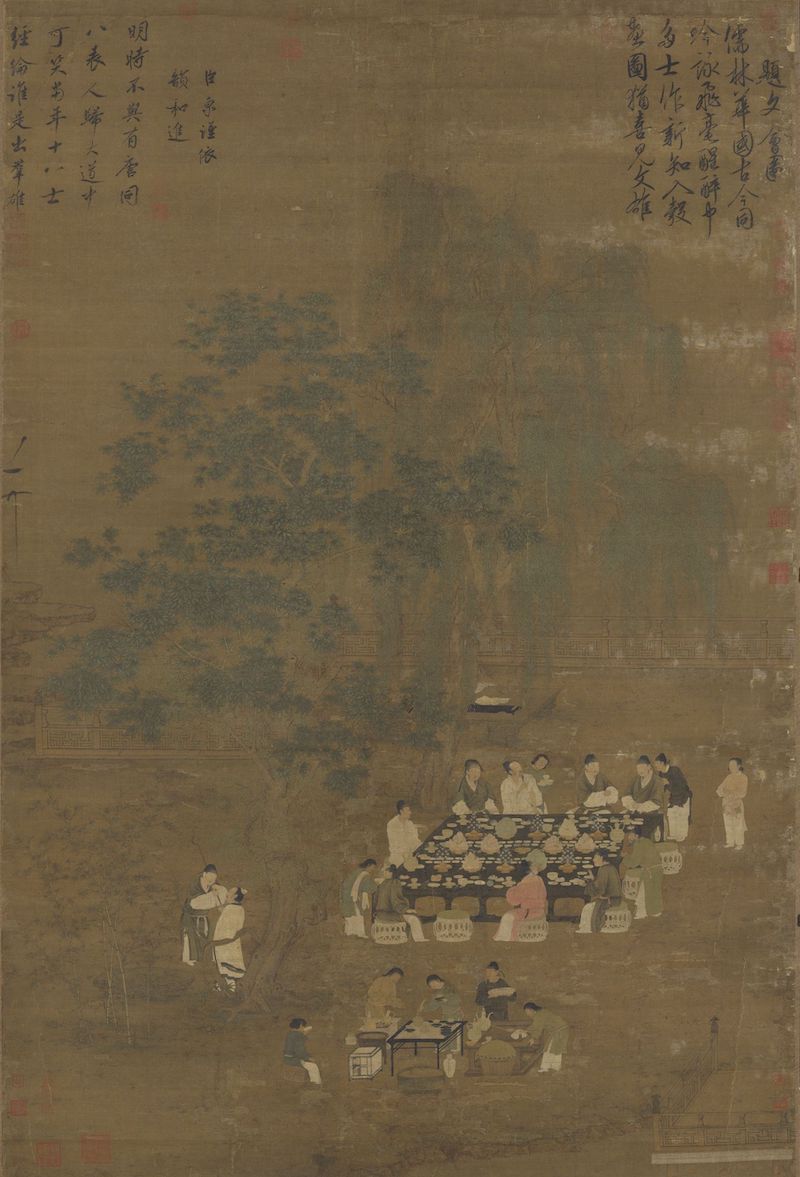
Emperor Huizong of the Song Dynasty (Style) Collection of the National Palace Museum, Taipei
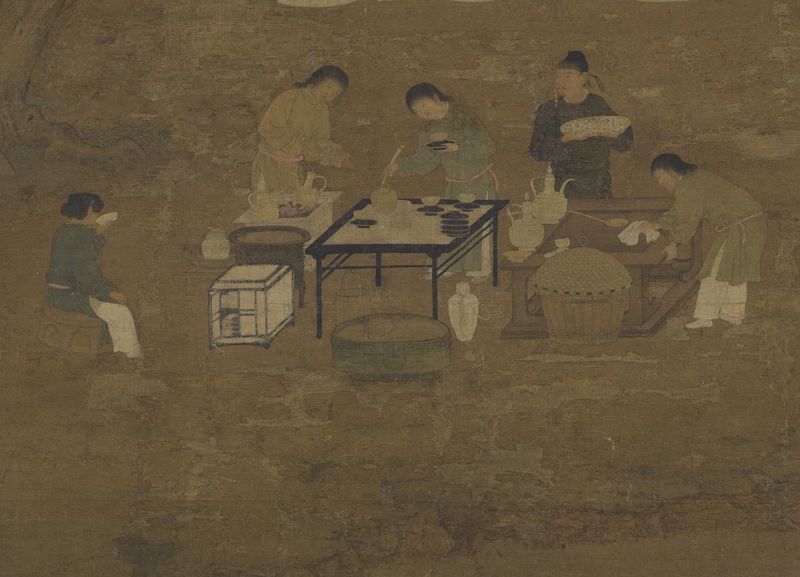
Emperor Huizong of Song Dynasty (Style) Wenhui Map Axis (Partial) Collection of National Palace Museum, Taipei
In "Wen Hui Tu", under the old willows and ancient locust trees, literati lay out huge cases, and the dishes on the case are arranged in an orderly manner. The servants in front of the painting are cooking tea and preparing wine, and one of them is holding a long-handled spoon. The tea powder is scooped out of the pot, which seems to be the "tea ordering method" that has been popular since the end of Tang Dynasty. We can also see the popularity of tea in the market in Liu Songnian's "Mingyuan Gambling in the Market" and "Tea Chasing" and Zhang Zeduan's "Riverside During the Qingming Festival".
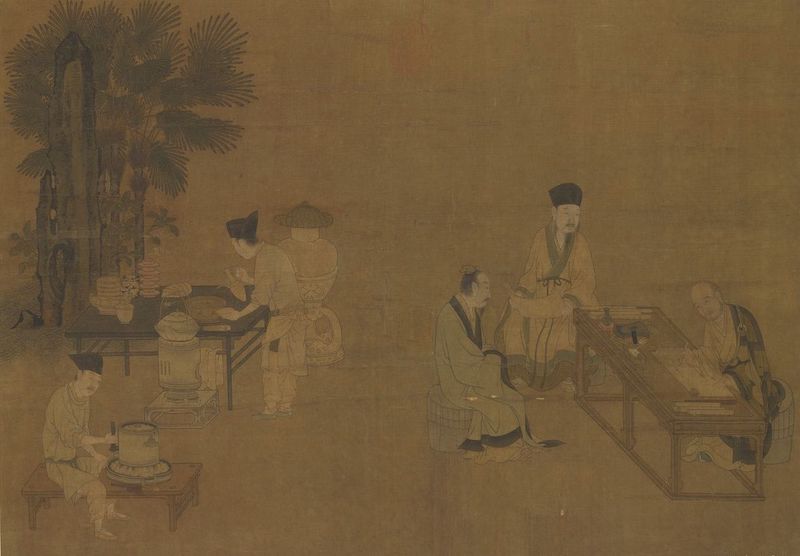
Song Dynasty Liu Songnian Pushing Tea Picture Scroll Collection of National Palace Museum, Taipei
Compared with the Tang Dynasty, the tea production in West Lake in the Song Dynasty had many developments: first, the tea area was greatly expanded; It is most praised, and the tea is already a strip-shaped loose tea, which retains the original shape of the buds and leaves; these loose teas are famous as "grass teas", and there is a poem by Master Ciyun as "Tianzhu grass tea, because of the name Xianglin tea". When the Song Dynasty advocated steamed and compacted round cake tea, West Lake "grass tea" was the first to open up the trend.
Although the West Lake Dragon Well has not yet appeared, the Song and Yuan literati and celebrities left many tea stories and poems and paintings in Hangzhou. Hu Ze and Fan Zhongyan in the Renzong Dynasty, Cai Xiang in the Yingzong Dynasty, Zhao Pu in the Shenzong Dynasty, and Su Shi in the Zhezong Dynasty were all good tea masters and left a lot of famous works. The reason is that tea is closely related to the life of literati, and it must also become an important source and material for their artistic creation.
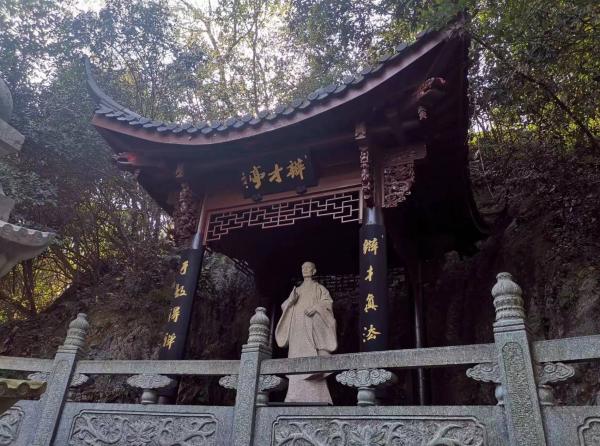
Biancai Pavilion in Old Longjing
The real connection between the name "Longjing" and tea begins with Master Biancai, an eminent monk in the Northern Song Dynasty. In the second year of Song Yuanfeng (1079), Biancai, the 69-year-old abbot of Shangtianzhu Temple, retired to a temple in Laolongjing, "Shoushengyuan". Unexpectedly, literati, celebrities and Buddhist believers visited one after another. In order to facilitate the exchange of pilgrims, Biancai had to renovate the mountains, open up roads, and plant green bamboos. This winding mountain road is now the "Fenghuangling" of Longjing Scenic Area. Biancai used to treat guests with good tea, and more and more tea trees were planted near Shousheng Yuan, and the "Longjing Tea Garden" began to take shape. Wang Anguo, Wang Anshi's younger brother, has a sentence in "West Lake Spring Day": "Chunyan Temple beats the tea drum", which fully expresses the prosperity of the tea event in the West Lake Temple.
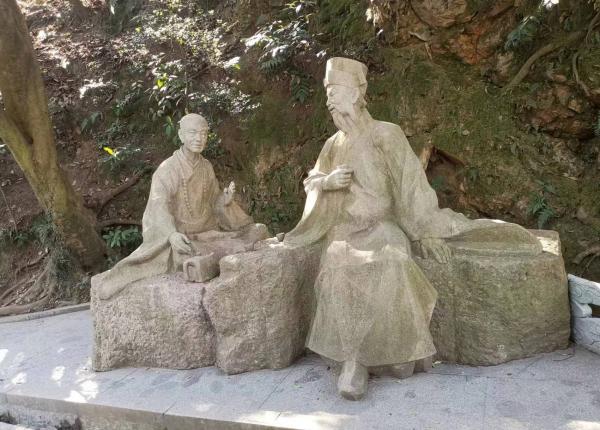
In Longjing Village, the stone statue of Biancai drinking tea with Su Shi
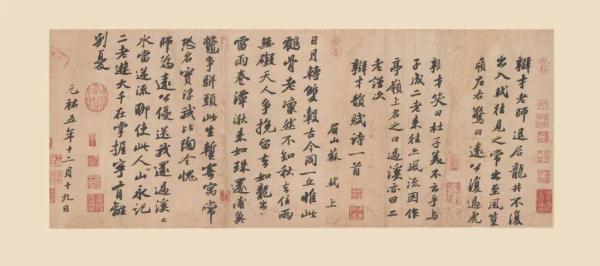
Su Shi's "Ci Bian Cai Yun Poetry Post"
The friendship between Biancai and Su Shi is particularly strong. Su Shi went out to know Hangzhou, and often went to the courtyard to pay homage in his spare time, where eminent monks and celebrities cooked tea and discussed the Tao. One day, Biancai saw Su Dongpo off the mountain, chatting as he walked, and was extremely speculative. Biancai forgot to see off the guests but the rules of Huxi, and the attendants on the left and right exclaimed, "Master, I have sent you past Huxi!" But Biancai laughed at Du Fu's poem: He and Zicheng are two elders, and they are also romantic in the past. After Biancai wrote "Longjing Xinting's Early Completion Poetry Presented to the Master Su Hanlin", Su Shi wrote poems for this, and wrote "Cibiancai Rhyme Poetry Post", which stated the deep friendship between the two and praised Biancai's detachment.
Mi Fu's early running script inscription "The Story of Fangyuan Temple in Longjing Mountain" is also related to Master Biancai. In the sixth year of Song Yuanfeng (1083), Master Shouyi, a monk official in Nanshan, Hangzhou, went to Longjing Shousheng Temple to pay homage to Biancai. For this reason, Shouyi wrote "The Story of Fangyuan Temple in Longjing Mountain". This stele was written by Mi Fu, introducing Fangyuan Nunnery in Longjing Mountain, Hangzhou. The original stone was carved in the sixth year of Yuanfeng (1083) in the Northern Song Dynasty. The calligraphy is rich and elegant, which is a masterpiece of Mi Fu's "collecting ancient characters" period.

Stele Book of Fangyuan Temple in Mi Fu's Running Script of the Northern Song Dynasty (partial)
He planted tea trees in Longjing, cooked good tea, and wrote poems and poems in Longjing. Since then, he has created a classic work of West Lake tea culture landscape - "Longjing Asking Tea".
The first appearance of the text of drinking "Longjing tea" appeared in the poems of Yu Ji, one of the "Four Masters of Yuan Dynasty". In the Yuan Dynasty, the tea-making method of steaming green tea and pressing it into agglomerates was gradually eliminated, and the loose tea-making method similar to the modern tea-making process was developed, and Longjing tea has already emerged. In his later years, Yu Ji lived at the foot of Wushan Mountain in Hangzhou. He visited Longjing with friends such as Deng Wenyuan, who was known as the "Three Great Calligraphers in the Early Yuan Dynasty", and wrote "Deng Wenyuan's Tour of Longjing":
Zhang Cheno enters Nanshan Mountain, but immediately enjoys the wonderful show.
The old man who is pregnant with the jade bureau, comes and goes to and from the old days.
The free pine is in the stream, and I still play the piano.
Wandering on the Dragon Well, the clouds rise and the sun rises.
Avoid splashing when you get started, and get rid of the messy moss.
Yanggang buckles the marble, and the yin room is absolutely relict.
The Duke of Cheng loves guests, and fetches water to pour into the secluded sinus.
Sitting in my divination, the lingering fragrance does not smell.
But you can see the clear water in the ladle, and the emerald shadows fall in the mountains.
When cooking golden buds, do not take after the rain.
The second and third sons came together, but the third swallowed and couldn't bear to rinse.
The lecture halls are clustered together, and thousands of people sit and chant.
The waves are mixed with rain, and the sinking is clear.
Make me conceive of childhood learning, Hu is wrapped in chapters and ribbons.
"But you can see the clearness in the ladle, and the green shadows fall in the mountains" is the color of Longjing tea. "Cooking and frying golden buds" names the form of good tea. "It even brings the taste of Longjing to life on paper.
Wang Jianrong interpreted this poem: "In the Yuan Dynasty, there was already a kneading process, and the dry tea was kneaded into a rope shape. Steamed green leaf buds are divided into bud tea and leaf tea according to the difference between fresh leaves, old and tender, as described in Yu Ji's poems. It belongs to the category of bud tea. Due to the innovation of technology, Longjing tea is different from traditional round cake tea for its fresh and light taste and the natural and straight posture of tea buds, which has been affirmed by more and more people. At that time, Longjing tea had already emerged. It once proposed Longjing tea, and described the beauty of Longjing tea collected before Guyu and shaped like 'golden buds' after brewing with Longjing water."
Yu Ji's masterpiece promoted the spread of Longjing tea, and the elegant story between him and Deng Wenyuan, who tasted Longjing in Longjing Mountain, was also passed down as a good story.

Axis of Ming Dynasty Tea Tasting Picture
Since the Ming Dynasty, Longjing tea has become the target of literati. Thanks to Zhu Yuanzhang's act of "stop making dragon groups", loose tea gradually became the mainstream, and the tea drinking habits of the Ming Dynasty were changed, and Longjing tea began to become famous all over the world. Scholars and refined scholars took Longjing tea as the theme one after another, writing books, composing poems, and painting, and their artistic pursuit of tea also reached its peak.
(Four)
The nature of tea is noble and pure, and the literati in the Ming Dynasty paid more attention to creating the space art of drinking tea. The preferred environment for drinking tea is quiet mountains and forests, as described in Ming Dynasty calligrapher Luo Lin's "Tea Solution": "Sit in the mountain hall at night, drink springs to cook tea, and fight with water and fire. It is like listening to the pines, full of fragrance, and the clouds are shining brightly." Lian. At this time, it's interesting, so it's hard to talk to ordinary people."

Ming Tang Yin's "Ming Ming Tu"
The aesthetics of this tea-drinking environment was also fully expressed in many paintings at that time. Wen Zhengming's "Huishan Tea Party Picture", Tang Yin's "Minming Tea Picture" and Wang Wen's "Tea Brewing Picture" are all very representative tea paintings.

King Ming asked about making tea (partial)
"Old Man of Ivy" Xu Wei is not only the pioneer of Chinese freehand brushwork painting, but also made great contributions to tea culture. His posthumous calligraphy "Seven Classes of Sencha" clearly puts forward the theory of the realm of suitable tea, and believes that the highest realm of tea is suitable for those who have the ideal environment, art environment, human environment and state of mind. "Seven Classes of Sencha" was roughly written around 1575. The book is about 250 characters, and it is divided into seven chapters: character, spring tasting, fried point, tasting tea, tea suitable, tea lover, and tea honor. The calligraphy in this volume is exquisite, absorbing the charm of Song Mifu, Huang Tingjian and Yuan Dynasty Ni Yunlin, with elegant lines and no dull atmosphere. It is a masterpiece of calligraphy art and tea culture.
In the environment suitable for tea, Xu Wei first promoted "personality", pointing out that "although fried tea is slightly clean and elegant, it must be able to match people with tea, so the method is often passed on to the generations of Gaoliu Dayin and Yunxiaquanshi". The most suitable drinking environment is "the quiet room on the balcony, the bright windows and the music, the monk's dormitory, the Taoist temple, the pine wind and the bamboo moon, Yan sitting and walking, and Qing Tan holding the scroll." The tea drinkers must be "Han Qing Mo Ke, Zi Liu Daoist priests, Yilao Sanren or disciples of Xuanmian, transcend the taste of the world." After drinking tea, they can "remove troubles and snow stagnation, and wake up broken diseases."
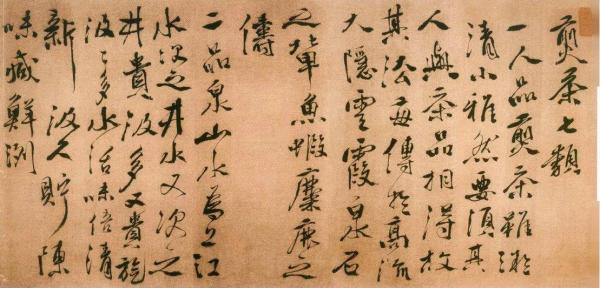
Xu Wei's "Seven Kinds of Sencha" is the first recommended character
The tea poems praised by literati in the Ming Dynasty are too numerous to enumerate. Chen Jiru, a writer, calligrapher and painter, wrote in "Testing Tea" "Ask Zizhan from the source of Longjing, and I was born half-close to Zen. Springs come from stones and are suitable for love. Tea The taste is more rounded from the peak." Mountains and rivers are the way, and a piece of small tea leaves also carries the transcendent awareness of life of Chinese literati.
When it comes to the famous Longjing tea poems, the largest number of contributors must be Emperor Qianlong. Emperor Qianlong went to the south of the Yangtze River six times, came to the Longjing tea area four times, visited the West Lake tea area for the first time, and wrote "Watching Tea and Composing Songs". After that, he traveled to the West Lake several times, and wrote "Sitting on the Dragon Well and Cooking Tea Occasionally" and "Revisiting the Dragon Well". After returning to the capital, Emperor Qianlong never forgot about Longjing tea. Before and after, he wrote tea poems such as "tea before the rain", "cooking Longjing tea", "Xiang Shengmo's picture of roasting tea in Songyin, using its rhyme".
Qianlong's trip to Longjing not only tasted and appreciated, but also carefully observed the picking and frying techniques of Longjing. The tea sage Lu Yu said in the "Tea Classics" that "tea picking should be in February, March and April", which is calculated into the current Gregorian calendar, which is between March and May. But Qianlong put forward higher requirements. He wrote in "Watching and Picking Tea Songs" that "you are young before the fire, and you are old after the fire. Only riding on fire is the best." The "fire" here refers to the Cold Food Festival. The Cold Food Festival originated in the Spring and Autumn Period. After Tang Ruowang's calendar reform in the Qing Dynasty, it was set as the day before Qingming. Because it is too close to the Ching Ming Festival, people gradually return to the Ching Ming Festival and despise cold food.
Qianlong paid attention to the taste. He thought that although the Longjing tea before the Cold Food Festival was full of fragrance and tender, the taste was still a little bland, while the taste of Longjing tea after the Cold Food Festival was too mellow. Qianlong's appreciation of Longjing tea has also influenced the present, and Longjing tea around the Ching Ming Festival is particularly precious.

Qianlong hand-picked eighteen imperial tea trees in Longjing Village
In front of the Hugong Temple in Longjing Village, there are eighteen imperial tea trees handpicked by Qianlong. If tea lovers are interested, they can also participate in the annual Royal Tea Tree Longjing Tea Auction to taste the taste of Longjing tea that Emperor Qianlong once tasted.
In the aesthetics of ancient literati, paintings must have meaning beyond the picture, poems must have meaning beyond words, and the same is true for tea. Lu Ciyun, a poet in the Qing Dynasty, praised Longjing and said: "Sip it indifferently, as if tasteless. After drinking it, I feel a kind of Taihe Qi, which permeates between the teeth and cheeks. This tasteless taste is still delicious." The "taste of tasteless" Taihe Qi is the "most flavor" in tea. This evaluation is not unsophisticated, and it also raises the taste of tea to the height of philosophy.

Jinnong "Mr. Yuchuan Fried Tea Picture"
Jinnong, one of the "Eight Eccentrics of Yangzhou", is also from Qiantang. He is good at poetry, calligraphy and calligraphy. Representatives of them. In "Yu Chuanzi's Love of Tea", the sentence "People's tea cooking rate is unreliable, but those who really know its taste are rare", which also shows Jinnong's view on the true taste of tea.
Looking at the evolution and development of West Lake Longjing tea for more than a thousand years, it is actually a process in which Chinese literati and the West Lake mountains and rivers coexist, benefit and blend together. In the world, the cage is everywhere. In addition to poetry, calligraphy, painting and seal, they also draw their hearts to this small bud and leaf, creating a carefree world in it. It also allows us to feel their aesthetic interest when we hold the cup thousands of years later.

